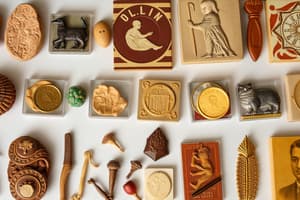Podcast
Questions and Answers
What type of evidence is blood type?
What type of evidence is blood type?
- Class characteristic (correct)
- Individual
- Both class and individual
- None of the above
What type of evidence is DNA?
What type of evidence is DNA?
- Class characteristic
- Individual (correct)
- Both class and individual
- None of the above
What type of evidence is saliva?
What type of evidence is saliva?
- Class characteristic
- Individual (correct)
- Both class and individual
- None of the above
What type of evidence is hair without a skin tag?
What type of evidence is hair without a skin tag?
What type of evidence is handwriting?
What type of evidence is handwriting?
What type of evidence is computer paper?
What type of evidence is computer paper?
What type of evidence is torn paper?
What type of evidence is torn paper?
What type of evidence is standard paint from a car?
What type of evidence is standard paint from a car?
What type of evidence is an explosive device?
What type of evidence is an explosive device?
What type of evidence are fibers?
What type of evidence are fibers?
What type of evidence are fingerprints?
What type of evidence are fingerprints?
What type of evidence is broken glass?
What type of evidence is broken glass?
What type of evidence are tire tracks?
What type of evidence are tire tracks?
What type of evidence are bite marks?
What type of evidence are bite marks?
What type of evidence is a shoe print?
What type of evidence is a shoe print?
What type of evidence is a custom paint job on a car?
What type of evidence is a custom paint job on a car?
What type of evidence is soil?
What type of evidence is soil?
What type of evidence are tool marks?
What type of evidence are tool marks?
Flashcards are hidden until you start studying
Study Notes
Evidence Classification
- Blood Type: A class characteristic used to identify characteristics common to a group.
- DNA: An individual characteristic, unique to each person, used for identification.
- Saliva: An individual characteristic as it contains DNA, aiding personal identification.
Individual vs. Class Characteristics
- Hair: Can be classified as individual if containing a skin tag; otherwise considered a class characteristic.
- Handwriting: Tied to an individual, as it reflects personal style and uniqueness.
- Computer Paper: A class characteristic, representing generic properties typical of a specific batch or brand.
- Torn Paper: An individual characteristic, as its unique torn edges can link to a specific source.
Specific Evidence
- Standard Paint from a Car: A class characteristic, as it indicates a type of paint rather than a specific vehicle.
- Explosive Device: Identified as an individual characteristic, as specific features can trace back to a unique source.
- Fibers: Class characteristic; they represent common fibers that can associate with items rather than pinpoint an individual.
Identifying Features
- Fingerprints: Individual characteristic, as they are unique to each person and provide reliable identification.
- Broken Glass: An individual characteristic, as the specific break pattern can be matched to a source.
- Tire Tracks: A class characteristic; shares common designs identifiable to a specific make/model but not uniquely.
- Bite Marks: Individual characteristic due to unique dental patterns that can trace back to an individual.
Class vs. Individual Evidence
- Shoe Print: Considered a class characteristic, indicating generic shoe type rather than unique ownership.
- Custom Paint Job on Car: Individual characteristic, as it reflects modifications that set a vehicle apart.
- Soil: A class characteristic, reflecting the common attributes of a geographical area.
- Tool Marks: Generally class, unless damaged or engraved, which can lead to individual identification.
Studying That Suits You
Use AI to generate personalized quizzes and flashcards to suit your learning preferences.




